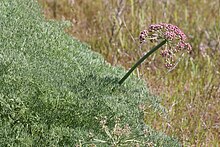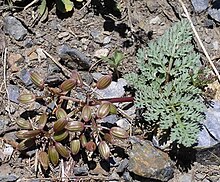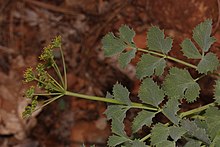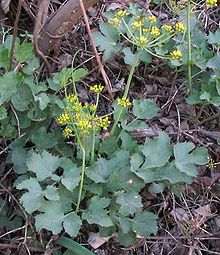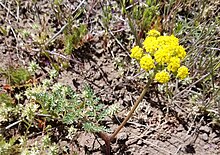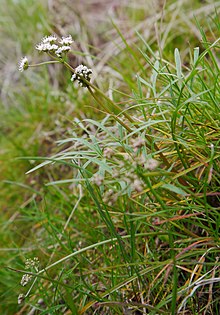Lomatium is a genus of plants withinthe umbelliferae family (Apiaceae). The 100 to 120 species as of 2018 are mainly distributed in North America .
description
Vegetative characteristics
Lomatium species are perennial herbaceous plants . All types are very long-lived; some specimens are known to be over 100 years old. Tap roots or deep-lying plant tubers are formed as persistence organs . The above-ground parts of the plant are hairy bald to woolly. In some species stems are not recognizable, in other species upright stems are simple or branched. At the base of the stem of some species there is a fibrous tuft of dead leaf sheaths .
The leaves are divided into leaf sheaths, petioles and leaf blades. The leaf blades are shaped very differently: simple and elongated, triangular-ovoid or obovate; one to multiple pinnate parts or one to multiple three-part composite. The leaf segments are shaped very differently.
There is no known toxic species of Lomatium .
Generative characteristics
There are distinct inflorescence stems. The flowers stand together in clearly double-gold inflorescences . Bracts are missing. The husk leaves are mostly present and conspicuous, rarely missing. The rays are spread out to upright and mostly winged at their base.
The flowers predominantly hermaphroditic and five-fold. Calyx teeth are missing. The five free, white, yellow or purple-colored petals are wide and narrow towards the top. There are five stamens . The two-chamber ovary is subordinate. There are two scars.
There are Doppelachänen formed. The linear to obovate individual fruits are flattened from the front to the back. The main ribs on the edge of the flat split fruit are broad to narrow, thin or thick winged or sometimes thread-like. The main ribs on the back protrude clearly. There are one or more oil streaks per rib interval. The fruit holder is free and split down to the bottom or there is a corky bar along the middle of the individual fruit. The seeds are flat to concave.
Systematics and distribution
Taxonomy
The genus Lomatium was established in 1819 by Constantine S. Rafinesque-Schmaltz in Journal de Physique, de Chimie, d'Histoire Naturelle et des Arts , Volume 89, Page 101. Type species is Lomatium villosum Raf. The generic name Lomatium is derived from the Greek and refers to the fact that the fruit is surrounded by a distinct wing. Synonyms for Lomatium Raf. are: Cogswellia Spreng. , Cusickia M.E.Jones , Cynomarathrum Nutt. , Euryptera Nutt. ex Torr. & A. Gray , Leibergia J.M. Coult. & Rose , Leptotaenia Nutt. ex Torr. & A.Gray .
There are three important monographs on the genus Lomatium : Mildred E. Mathias : A revision of the genus Lomatium. In: Annals of the Missouri Botanical Garden , Volume 25, 1937/8, pp. 225-297; John Merle Coulter , Joseph Nelson Rose : Umbelliferae In: Contributions from the United States National Herbarium , Volume 7, 1, 1900; Mark Schlessman: Systematics of Tuberous Lomatiums. In: Systematic Botany Monographs , Volume 4, 1984.
External systematics and botanical history
The genus Lomatium belongs to the tribe Selineae in the subfamily Apioideae within the family Apiaceae . The North American species of Peucedanum sl are, for example, in Lomatium Raf. or Cymopterus Raf. been outsourced. To the genus Orogenia S.Wats. only two species remain, the third species was added to Lomatium in 2017 .
Species and their distribution
The Lomatium species are mainly found in North America. Few species are also found in Mexico. Neither species is considered an invasive plant .
Many species of Lomatium occur only in a small area. 13 species were first described between 1973 and 2016. In 2017, Feist et al. some new combinations. In 2018 and 2019, new species were described and the rank of taxa changed.
The Lomatium species are genetically clearly defined, no transitions are known. There are no known hybrids in the genus Lomatium .
Kinship groups are discussed, which are referred to as complex. For example Lomatium grayi complex or Lomatium brevifolium complex.
The genus Lomatium includes 100 to 120 species since 2018:
-
Lomatium ambiguum (Nutt.) Coult. & Rose : It occurs in western North America from the Canadian province of southern British Columbia to the US states of northeast Oregon , northern and eastern Washington , western Montana , northwest Wyoming , Idaho and north-central Utah .
-
Lomatium attenuatum E.F.Evert : It was first described in 1983.
-
Lomatium austiniae (Coult. & Rose) Coult. & Rose : It occurs only in western Nevada and in northeastern California only in Plumas County .
-
Lomatium basalticum Mansfield & M.Stevens : It was first described in 2016. This endemic has so far only been found in the area around Hells Canyon in Oregon and Idaho.
-
Lomatium bentonitum K.M. Carlson & Mansfield : It was first described in 2011 from southeastern Oregon.
-
Lomatium bicolor (S.Wats.) Coult. & Rose : There are two varieties:
-
Lomatium bicolor (S.Wats.) Coult. & Rose var. Bicolor : It occurs in the western US states of southeastern Idaho, southwestern Wyoming and north-central Utah.
-
Lomatium bicolor var. Leptocarpum (Nutt. Ex Torr. & Gray) MASchlessman (Syn .: Peucedanum triternatum var. Leptocarpum Torr. & A.Gray , Lomatium leptocarpum (Torr. & A.Gray) JMCoult. & Rose ): She comes in the western US states western Colorado , Idaho, eastern to central Oregon, southeast Washington, southern Wyoming , northern Arizona, northern Nevada and northern California.
-
Lomatium bradshawii (Rose ex Mathias) Mathias & Constance : This rare species is found only in the northwestern Willamette Valley in Oregon and southwestern Washington.
-
Lomatium brandegeei (Coult. & Rose) JFMacbr. : This endemic occurs only in western Washington .
-
Lomatium brunsfeldianum Kemper & RPMcNeill : It was first described in 2012.
-
Lomatium californicum (Nutt. Ex Torr. & Gray) Mathias & Constance : It occurs in the western US states of southern Oregon and California.
-
Lomatium canbyi (Coult. & Rose) Coult. & Rose : It occurs in the western US states of western Idaho, eastern Oregon, eastern Washington, northeastern California and northwestern Nevada.
-
Lomatium caruifolium (Hook. & Arn.) Coult. & Rose : There are two varieties:
-
Lomatium caruifolium (Hook. & Arn.) Coult. & Rose var. Caruifolium : It occurs in large parts of California.
-
Lomatium caruifolium var. Denticulatum (Jeps.) Jeps. : This endemic occurs only in northern California.
-
Lomatium ciliolatum Jepson : This endemic is mainly found in northwestern California.
-
Lomatium columbianum Mathias & Constance
-
Lomatium concinnum (Osterh.) Mathias
-
Lomatium congdonii Coult. & Rose : This endemic occurs only in central California in the foothills of the Sierra Nevada.
-
Lomatium cookii J.S. Kagan : It was first described in 1986. This endemic occurs only in southwest Oregon.
-
Lomatium cous (S.Wats.) Coult. & Rose (Syn .: Peucedanum cous S.Watson ): It occurs in the northwestern US states of Idaho, Montana, Oregon, Washington and Wyoming.
-
Lomatium cusickii (S.Wats.) Coult. & Rose
-
Lomatium cuspidatum (Coult. & Rose) Mathias & Constance
-
Lomatium dasycarpum (Torr. & Gray) Coult. & Rose : There are two subspecies:
-
Lomatium dasycarpum (Torr. & Gray) Coult. & Rose subsp. dasycarpum : It occurs only from the US state of California to the Mexican Baja California .
-
Lomatium dasycarpum subsp. tomentosum (Benth.) Theob. : It occurs only in the central part of the US state California.
-
Lomatium depauperatum (MEJones) JAAlexander & W.Whaley (Syn .: Cogswellia millefolia . Var depauperata M.E.Jones , Lomatium grayi var. Depauperatum (MEJones) Mathias ): This new combination and change in the ranking took place in 2018. It comes in the western USA in Nevada as well as Utah.
-
Lomatium dissectum (Nutt. Ex Torr. & Gray) Mathias & Constance : It occurs in western North America from the Canadian province of British Columbia to the US states of Idaho, Oregon, Washington and California.
-
Lomatium donnellii (Coult. & Rose) Coult. & Rose (Syn .: Lomatium plummerae (JMCoult. & Rose) JMCoult. & Rose , Peucedanum donnellii J.M.Coult. & Rose , Peucedanum plummerae J.M.Coult. & Rose ): It occurs in the western US states of eastern Oregon, northwestern Nevada as well northeastern California.
-
Lomatium eastwoodiae (Coult. & Rose) JFMacbr.
-
Lomatium engelmannii Mathias : It occurs in the western USA only in southwest Oregon and northern California.
-
Lomatium erythrocarpum R.J. Meinke & L.Constance : It was first described in 1984. This endemic occurs only in Baker County , Oregon.
-
Lomatium farinosum (Geyer) Coult. & Rose : There have been two varieties since 1978:
-
Lomatium farinosum (Geyer) Coult. & Rose var. Farinosum : It occurs in the western US states of northern Idaho, eastern Washington and perhaps in Missoula County in Montana.
-
Lomatium farinosum . Var hambleniae (Mathias & Constance) Schlessman (Syn .: lomatium hambleniae Mathias & Constance ): it has since 1978, the rank of variety. It occurs in the western US states of north-central Oregon and central Washington.
-
Lomatium filicinum (MEJones) Mansfield & M.Stevens (Syn .: Leptotaenia filicina M.E.Jones ): This new combination took place in 2018.
-
Lomatium foeniculaceum (Nutt.) Coult. & Rose :
-
Lomatium foeniculaceum subsp. dahcifolium (Torr. & Gray) Theob.
-
Lomatium foeniculaceum subsp. fimbriatum W.L. Theob. : It occurs only in eastern California and Utah.
-
Lomatium foeniculaceum (Nutt.) Coult. & Rose subsp. foeniculaceum
-
Lomatium foeniculaceum subsp. inyoense (Mathias & Constance) WLTheob. : It occurs only in California in the White and Inyo Mountains and could also occur in Idaho and Nevada.
-
Lomatium foeniculaceum subsp. macdougalii (Coult. & Rose) WLTheob. : It occurs in eastern California, eastern Oregon, Utah, Montana and Arizona.
-
Lomatium fusiformis (S. Watson) JFSm. & Mansfield (Syn .: Orogenia fusiformis S. Watson ): This new combination took place in 2017. It occurs in northern California and central Oregon.
-
Lomatium geyeri (S.Wats.) Coult. & Rose : It occurs in western North America in the US states of northern Idaho, Montana (only in Lincoln County ) and Washington.
-
Lomatium gormanii (TJHowell) Coult. & Rose
-
Lomatium graveolens (S.Wats.) RDDorn & RLHartman : There are two varieties:
-
Lomatium graveolens (. S.Wats) RDDorn & RLHartman var. Graveolens : It occurs States US Idaho, Wyoming and northern Utah in the Western.
-
Lomatium graveolens var. Alpinum (Wats.) RDDorn & RLHartman : It occurs in the western US states of eastern Nevada and Utah.
-
Lomatium grayi (Coult. & Rose) Coult. & Rose : The Lomatium grayi complex was edited in 2018, resulting in a new distribution area for Lomatium grayi s. st. It occurs in the US states of Colorado, Idaho, Utah, Wyoming and New Mexico .
-
Lomatium greenmanii Mathias : This endemic is only found in Wallowa County , Oregon.
-
Lomatium hallii (S.Wats.) Coult. & Rose : It occurs in northern California and Oregon.
-
Lomatium hendersonii (Coult. & Rose) Coult. & Rose : It occurs in the western US states of Oregon, Idaho, Nevada and in northern California.
-
Lomatium hooveri (Mathias & Constance) L.Constance & B.Ertter : This endemic species occurs in California only in the Inner North Coast Ranges .
-
Lomatium howellii (S.Wats.) Jepson : It occurs in the western USA only in southwest Oregon and northern California.
-
Lomatium idahoense Mathias & Constance
-
Lomatium insulare (Eastw.) Munz This endemic occurs only on the two islands of the Californian island of San Nicolas and the Mexican Isla Guadalupe .
-
Lomatium junceum R.C.Barneby & NHHolmgren : It was first described in 1979.
-
Lomatium juniperinum (MEJones) Coult. & Rose
-
Lomatium klickitatense J.A.Alexander & W.Whaley : It was first described in 2018. It occurs in the western United States only in Washington in Klickitat County and in Oregon in Hood River County and Wasco County .
-
Lomatium knokei Darrach : It was first described in 2014.
-
Lomatium kogholiini Mason & Willie : It was first described in 2019. Herbarium belonging to this species was attributed to three species up to 2019: Lomatium congdonii , Lomatium engelmannii and Lomatium tracyi . The endemic thrives only on ultramafic rocks in Red Mountain in northern Mendocino County , California.
-
Lomatium laevigatum (Nutt.) Coult. & Rose
-
Lomatium latilobum (Rydb.) Mathias : It occurs in the western US only in Mesa County in Colorado and Grand and San Juan County in Utah.
-
Lomatium linearifolium (S.Watson) JFSm. & Mansfield (Syn .: Orogenia linearifolia S. Watson ): This new combination took place in 2017.
-
Lomatium lithosolamans J.F.Sm. & Feist (Syn .: Tauschia hooveri Mathias & Constance non Lomatium hooveri (Mathias & Constance) Constance & Ertter ): This name is new in 2017.
-
Lomatium lucidum (Nutt.) Jepson : It occurs in California from Santa Barbara to San Diego County and in the northern part of the Mexican Baja Califormia.
-
Lomatium macrocarpum (Hook. & Arn.) Coult. & Rose (Syn .: Peucedanum macrocarpum Nutt. Ex Torr. & A.Gray ): It is found in western to central North America from Canadian southern Saskatchewan, southern Alberta , southern Manitoba and southern British Columbia and in the US states northern and western North Dakota, South Dakota ( Harding County only), Idaho, Montana, Oregon, Washington, Wyoming, California, and northern Utah and perhaps northern Colorado.
-
Lomatium marginatum (Benth.) Coult. & Rose : There are two varieties:
-
Lomatium marginatum (Benth.) Coult. & Rose var. Marginatum : It occurs in northern to central California.
-
Lomatium marginatum var. Purpureum Jeps. : This endemic thrives at altitudes of 300 to 800 meters only in the Northern Coast Mountains in California.
-
Lomatium martindalei (Coult. & Rose) Coult. & Rose : It occurs in western North America in the southwestern part of British Columbia and in the US states of western Oregon, western Washington and northwestern California.
-
Lomatium minimum (Mathias) Mathias
-
Lomatium minus (Rose ex Howell) Mathias & Constance
-
Lomatium mohavense (Coult. & Rose) JMCoult. & Rose : A subspecies has been described:
-
Lomatium mohavense subsp. longilobum Theobald
-
Lomatium mohavense (Coult. & Rose) JMCoult. & Rose subsp. mohavense : It comes from California, Baja California.
-
Lomatium multifidum (Nutt.) RPMcNeill & Darrach (Syn .: Lomatium dissectum var. Multifidum (Nutt.) Mathias & Constance , Leptotaenia multifida Nutt. , Leptotaenia dissecta var. Multifida (Nutt.) Jepson , Ferula multifida (Nutt.) Gray ) : It has had the rank of a species since 2017. It comes in western North America from the Canadian provinces of Alberta and British Columbia via the US states of Colorado , Idaho, Montana, Oregon, Washington, Wyoming , Arizona , Nevada, Utah and California to Mexico State of Baja California .
-
Lomatium nevadense (S.Wats.) Coult. & Rose : There are two varieties:
-
Lomatium nevadense (S.Wats.) Coult. & Rose var. Nevadense : It occurs in the US states of Oregon, Arizona , Nevada, Utah and in eastern California.
-
Lomatium nevadense var. Parishii (Coult. & Rose) Jeps. (Syn .: Lomatium nevadense . Var holopterum Jeps. , Lomatium nevadense var. Pseudorientale (MEJones) Munz ): It comes in the states western New Mexico , Nevada and Mexico in the mountains of California and in the northern state of Sonora before.
-
Lomatium nudicaule (Pursh) Coult. & Rose : It occurs in western North America in the Canadian province of British Columbia and in the western US states of Idaho, Oregon, Washington, Nevada, Utah and northern California.
-
Lomatium nuttallii (A. Gray) Macbr. : It occurs in the US states of Nebraska, Colorado, Wyoming and New Mexico.
-
Lomatium observatorium L.Constance & B.Ertter : It was first described in 1996. This endemic has so far only been found in the Californian Mount Hamilton Range at altitudes of 1280 to 1330 meters.
-
Lomatium ochocense Helliwell & Constance : It was first described in 2010.
-
Lomatium oreganum Coult. & Rose
-
Lomatium orientale Coult. & Rose : It is distributed in North America from the Canadian provinces of Saskatchewan and Manitoba in the US states of Utah, Iowa , Kansas , Minnesota , Nebraska, North Dakota, South Dakota, Colorado, Idaho, Montana, Wyoming and New Mexico.
-
Lomatium packardiae A.Cronquist : It was first described in 1992.
-
Lomatium papilioniferum J.A.Alexander & W.Whaley : It was first described in 2018. It occurs in western North America in the Canadian province of British Columbia and in the US states of Washington and California.
-
Lomatium parryi (S.Wats.) JFMacbr. : It occurs in the California Dessert Mountains and in Utah and Arizona.
-
Lomatium parvifolium (Hook. & Arn.) Jeps. : It occurs only in western-central California in the Ksütengebirge.
-
Lomatium pastoralis Darrach & DHWagner : It was first described in 2011.
-
Lomatium peckianum Mathias & Constance : It occurs in the Klamath Mountains in northern California and southern Oregon.
-
Lomatium piperi Coult. & Rose : It occurs in northern California and Washington.
-
Lomatium planosum (Osterh.) Mansfield & SRDownie (Syn .: Aulospermum planosum Osterh. , Cymopterus planosus (Osterh.) Mathias ): This new combination took place in 2017.
-
Lomatium quintuplex M.A. Schllessman & L.Constance : It was first described in 1979 from the US state Washington.
-
Lomatium ravenii Mathias & Constance : There have been two varieties since 2011:
-
Lomatium ravenii var. Paiutense K.M. Carlson & Mansfield : It was first described in 2011. It occurs in the western United States in California in eastern Lassen County and southeastern Modoc County and in Oregon, Idaho and western Utah.
-
Lomatium ravenii Mathias & Constance var. Ravenii : It occurs in California in the vicinity of Ravendale and Painter's Plain and in eastern Lassen County.
-
Lomatium roneorum Darrach : It was first described in 2018. This endemic occurs only on the eastern slopes of the Cascades Mountains in western Washington State.
-
Lomatium repostum (Jeps.) Mathias : This endemic only occurs in the California coastal mountains at altitudes of 100 to 800 meters.
-
Lomatium rigidum (MEJones) Jeps. : This endemic occurs only in Big Pine, Bishop creeks, California, and Inyo County .
-
Lomatium rollinsii Mathias & Constance
-
Lomatium roseanum A.Cronquist
-
Lomatium salmoniflorum (Coult. & Rose) Mathias & Constance
-
Lomatium sandbergii (Coult. & Rose) Coult. & Rose
-
Lomatium scabrum (Coult. & Rose) Mathias :
-
Lomatium scabrum (Coult. & Rose) Mathias var. Scabrum
-
Lomatium scabrum var. Tripinnatum S.Goodrich
-
Lomatium serpentinum (MEJones) Mathias
-
Lomatium shevockii R.L. Hartman & L.Constance : It was first described in 1988 .: This endemic occurs only in California's Kern County in the High Sierra Nevada at altitudes of 2200 to 2500 meters.
-
Lomatium simplex (Nutt.) JFMacbr. : There are two varieties:
-
Lomatium simplex var. Leptophyllum (Hook.) Mathias
-
Lomatium simplex (Nutt.) JFMacbr. var. simplex
-
Lomatium stebbinsii M.A. Schllessman & L.Constance : It was first described in 1979. This endemic occurs only in California's High Sierra Nevada at altitudes of 1250 to 1700 meters.
-
Lomatium suksdorfii (S.Wats.) Coult. & Rose : It only occurs in Washington State.
-
Lomatium swingerae McNeill : It was first described in 2014.
-
Lomatium tamanitchii Darrach & Thie : It was first described in 2010.
-
Lomatium tarantuloides Darrach & Hinchliff : It was first described in 2014. This endemic has so far only been found in northeastern Oregon.
-
Lomatium tenuissimum (Geyer ex Hook.) Feist & GMPlunkett (Syn .: Peucedanum tenuissimum Geyer ex Hook. , Tauschia tenuissima (Geyer ex Hook.) Mathias & Constance , Leibergia orogenioides Coulter & Rose , Cogswellia orogenioides (JMCoult. & Rose) Jones , Lomatium orogenioides (JMCoult. & Rose) Mathias ): This new combination took place in 2017.
-
Lomatium thompsonii (Mathias) Cronq.
-
Lomatium torreyi (Coult. & Rose) Coult. & Rose : This endemic occurs only in California's High Sierra Nevada at altitudes of 1100 to 3300 meters.
-
Lomatium tracyi Mathias & Constance : It occurs in the western US states of Oregon and northern California.
-
Lomatium triternatum (Pursh) Coult. & Rose : There are two to four varieties, but this family group is controversial:
-
Lomatium triternatum var. Anomalum (MEJones ex Coult & Rose.) Mathias : It comes in the western US states Idaho, northeastern Oregon, Wyoming before (in Lincoln County) and in northern Utah.
-
Lomatium triternatum var. Brevifolium (Coult. & Rose) Mathias
- Lomatium triternatum var. Macrocarpum (Coult. & Rose) Mathias : It occurs in the western US states of Washington, Idaho, Nevada and California.
-
Lomatium triternatum (Pursh) Coult. & Rose var. Triternatum : It occurs in western North America in the Canadian provinces of southern Alberta and southern British Columbia and in the US states of Idaho, northwestern Montana, southern Oregon and northern California.
-
Lomatium tuberosum Hoover
-
Lomatium utriculatum (Nutt. Ex Torr. & Gray) Coult. & Rose : It occurs in western North America in the Canadian province of British Columbia and in the western US states of Oregon, Washington and California.
-
Lomatium vaginatum Coult. & Rose : It occurs in the western US states of Oregon, western Nevada and northern California.
-
Lomatium watsonii Coult. & Rose
|
use
Use as food
From some Lomatium TYPES (eg Lomatium ambiguum , Lomatium canbyi , Lomatium cous , dissectum Lomatium , Lomatium eurycarpum , Lomatium farinosum , Lomatium foeniculaceum , Lomatium Gayéri , gormanii Lomatium , grayi Lomatium , Lomatium macrocarpum , nudicaule Lomatium , triternatum Lomatium , Lomatium utriculatum ) were Parts of plants eaten by some tribes of the North American indigenous peoples :
For some North American tribes, Lomatium ambiguum has been a staple food and is one of the two most versatile types of Lomatium . The underground parts of the plant were eaten raw or cooked. The underground plant parts can also be dried and ground; You can use this powder to flavor soups, for example. The seeds can be ground or eaten raw. The inflorescences and the upper leaves can be used to season salads or soups etc.
Lomatium macrocarpum has been a staple diet for some North American tribes and is one of the two most versatile types of Lomatium . The underground plant parts were mostly peeled before cooking or eating. The dried underground plant parts can be ground and used to bake cakes. The seeds are eaten raw or cooked and are very nutritious. The ground seeds are used as a spice when baking bread or, for example, to flavor soups. Although the seeds are relatively small, they are still easy to harvest. The leaves, stems and flowers can be used to make tea.
Use as a medicinal plant
The medicinal effects of some Lomatium species (for example Lomatium ambiguum , Lomatium dissectum , Lomatium macrocarpum , Lomatium nudicaule , Lomatium triternatum , Lomatium utriculatum ) were investigated. They have already been used in folk medicine .
swell
literature
- Mark E. Darrach: New Taxonomic Understanding And Persistent Confusions and Contusions Regarding Circumscribing Lomatium. University of Washington Botanical Symposium, 2016. Full-text PDF.
- Mary Feist, James Smith, Donald H. Mansfield, Mark E. Darrach, Richard McNeill, Stephen Downie, Gregory Plunkett, Barbara Wilson: New combinations in Lomatium (Apiaceae, subfamily Apioideae). Phytotaxa , Volume 316, Issue 1, August 2017, pp. 95-98. doi : 10.11646 / phytotaxa.316.1.11
- Lincoln Constance, Margriet Wetherwax, 2017. In Jepson Flora Project (eds.) Jepson eFlora : Lomatium online revision 5.
- EE George, Donald H. Mansfield, JF Smith, RL Hartman, SR Downie, CE Hinchliff: Phylogenetic analysis reveals multiple cases of morphological parallelism and taxonomic polyphyly in Lomatium (Apiaceae). In: Systematic Botany , Volume 39, 2014, pp. 662–675. doi : 10.1600 / 036364414X680843
- F.-J. Sun, SR Downie: A molecular systematic investigation of Cymopterus and its allies (Apiaceae) based on phylogenetic analyzes of nuclear (ITS) and plastid (rps16 intron) DNA sequences. In: South African Journal of Botany , Volume 70, Issue 3, 2004, pp. 407-416. doi : 10.1016 / S0254-6299 (15) 30223-4 full text PDF.
-
Mildred E. Mathias : A revision of the genus Lomatium. In: Annals of the Missouri Botanical Garden , Volume 25, 1937/8, pp. 225-297. doi : 10.2307 / 2394480
-
John Merle Coulter , Joseph Nelson Rose : Umbelliferae In: Contributions from the United States National Herbarium , Volume 7, 1, 1900.
- Mark A. Schlessman: Systematics of Tuberous Lomatiums. In: Systematic Botany Monographs , Volume 4, American Society of Plant Taxonomists, 1984, ISBN 978-0912861043 . doi : 10.2307 / 25027598
Individual evidence
-
↑ a b c d e f g h i j k l m n o p q r s t u v w x y z aa ab ac ad ae af ag ah ai aj ak al am an ao ap aq ar as at au av aw ax ay az ba bb bc bd be bf bg bh bi bj bk bl bm bn bo bp bq br bs bt bu
Lincoln Constance, Margriet Wetherwax, 2017. In: Jepson Flora Project (Ed.) Jepson eFlora : Lomatium online Revision 5.
-
↑ a b c d e f g h i j k l m n o p q r s t u v w x y z aa ab ac
Mark E. Darrach: New Taxonomic Understanding And Persistent Confusions and Contusions Regarding Circumscribing Lomatium. University of Washington Botanical Symposium, 2016. Full-text PDF.
-
^ Lomatium at Tropicos.org. Missouri Botanical Garden, St. Louis, Retrieved September 17, 2019.
-
↑ a b c d e f g h i j k l m n o p q r s t u v w x y z aa ab ac ad ae af ag ah ai aj ak al am an ao ap aq Lomatium in the Germplasm Resources Information Network (GRIN), USDA , ARS , National Genetic Resources Program. National Germplasm Resources Laboratory, Beltsville, Maryland. Retrieved September 15, 2019.
-
↑ a b c d e f g h i
Mary Ann E. Feist, James F. Smith, Donald H. Mansfield, Mark E. Darrach, Richard McNeill, Stephen R. Downie, Gregory M. Plunkett, Barbara Wilson: New combinations in Lomatium (Apiaceae, subfamily Apioideae). In: Phytotaxa , Volume 316, Issue 1, August 2017, pp. 95–98. doi : 10.11646 / phytotaxa.316.1.11
-
^ A b
Donald H. Mansfield, BL Wilson, JF Smith, Mark E. Darrach: Lomatium filicinum (Apiaceae): A new combination epitypified with Lomatium basalticum. In: Phytoneuron 2018-33, May 30, 2018 S, 1-4. Full text PDF.
-
↑ a b c d e
JA Alexander, W. Whaley, N. Blain: The Lomatium Grayi Complex (Apiaceae) of the Western United States: A taxonomic revision based on morphometric, essential oil composition, and Larva-Host coevolution studies. In: Journal of the Botanical Research Institute of Texas , Volume 12, Issue 2, October 20, 2018, pp. 387-444. Full text PDF.
-
↑ a b c d e f g h i j k l m n o p q r s t u v w x y z aa ab ac ad ae af ag ah ai aj ak al am an ao ap aq ar as at au av aw ax ay az ba bb bc bd be bf bg bh bi bj bk bl bm bn bo bp bq br bs bt bu bv bw bx by bz Vascular Plants of the Americas : Lomatium at Tropicos.org. In: 83 . Missouri Botanical Garden, St. Louis
-
↑
Donald H. Mansfield, M. Stevens, L. Polito, James F. Smith, Mark E. Darrach: 2016. Lomatium basalticum (Apiaceae), a new species from the vicinity of Hells Canyon in Oregon and Idaho. In: Phytoneuron , Volume 74, 2016, pp. 1–13.
-
^ A b
Donald H. Mansfield: The discovery of two new desert parsleys from southeastern Oregon: Lomatium ravenii var. Paiutense and Lomatium bentonitum. In: Kalmiopsis , Volume 21, 2015, pp. 17-25.
-
↑ Lomatium bradshawii (Rose ex Math.) Math. & Const. . In: Rare Plant Field Guide . Washington State, Department of Natural Resources. Retrieved September 18, 2019. from Pamela Camp, John G. Gamon: Field Guide to the Rare Plants of Washington , 2011.
-
↑
KM Mason, E. Willie, James F. Smith, J. Wheeler, BL Wilson: A new species of Lomatium (Apiaceae) from Red Mountain, a serpentine island in Mendocino County, Californa. Phytoneuron , Volume 10, 2019, pp. 1-18. Full text PDF.
-
^
Mark E. Darrach: Lomatium roneorum (Apiaceae), a new species from the east slopes of the Cascade Mountains, Washington state. In: Phytoneuron , Volume 78, November 5, 2018, pp. 1–12. Full text PDF.
-
^
Mark E. Darrach, Cody E. Hinchlif: Lomatium tarantuloides (Apiaceae), a new narrowly endemic species from northeast Oregon. In: Phytoneuron , Volume 27, 2014, pp. 1–8. Full text PDF.
-
↑ a b c d Entries on Lomatium at Plants For A Future
further reading
- E. George, Donald H. Mansfield, James F. Smith, R. Hartman, S. Downie, C. Hinchliff: Phylogenetic analysis reveals multiple cases of morphological parallelism and taxonomic polyphyly in Lomatium (Apiaceae). In: Systematic Botany , Volume 39, Issue 2, 2014, pp. 662-675.
- James F. Smith, Donald H. Mansfield, McKayla Stevens, Edgar Sosa, Mary Ann E. Feist, Stephen R. Downie, Gregory M. Plunkett, Mark Darrach: Try Tri again? Resolving species boundaries in the Lomatium triternatum (Apiaceae) complex. In: Journal of Systematics and Evolution , Volume 56, Issue 3, 2018, pp. 218-230. doi : 10.1111 / jse.12418
- McKayla Stevens, Donald H. Mansfield, James F. Smith, MAE Feist Resolving the Anomaly of Lomatium anomalum: Discovery of a New Species in Southwestern Idaho (USA), Lomatium andrusianum (Apiaceae). In: Journal of the Botanical Research Institute of Texas , Volume 12, 2018, pp. 1-15.
Web links
This article is about a health issue. It is
not used for self-diagnosis and
does not replace a diagnosis by a doctor. Please
note the information
on health issues !




